The Bagpipe Society
The Rosca: Part Two
In the first part of the article, Pablo Carpintero introduced the Rosca pipe and here, in part two, he continues his journey of exploration, reaching back into the history of both the Rosca and the bagpipe itself.
Rosca related bagpipes in Iberian medieval iconography
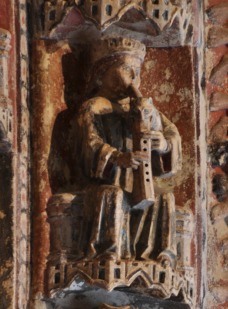
Assuming that cylindrical or square tubes were, as a rule, furnished with single reeds, we found in northwestern medieval iconography some bagpipes very similar to the rosca. There are a substantial number of Iberian depictions of this kind of bagpipe, but we will show only the clearest and best quality representations with all date from the 13th and 14th centuries.
In 1240-1260 the interior cover of the Toro Collegiate was built. Among the depicted musicians there is a king bagpiper whose drone-less instrument shows a single square chanter, without bell resonator, which comes out from a stock carved with a dog’s head (fig. 21).
On the south portal of the Burgos cathedral, so-called Puerta del Sarmental (13th century), we can see a king bagpiper whose drone-less instrument shows a double square chanter with a single resonator bell carved with a wolf or dog head (fig. 22).
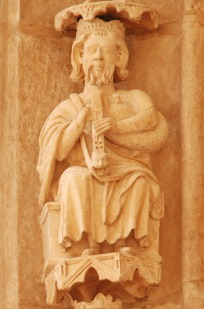
The western portal of León cathedral, built around 1270, shows a king bagpiper whose drone-less bagpipe has a double square chanter which comes out from a carved stock, finishing in a single carved resonator (fig. 23). The animals represented in both stock and bell are difficult to specify.
The south portal of Leon cathedral, built between 1265 and 1275, shows another beautiful representation of a king bagpiper (fig. 24-1). His bagpipe has a single square chanter which comes out from bag through a dog-head carved stock. On the chanter we can see, perfectly carved, a ring ornamentation. The final part of the chanter is broken, but it probably had a resonator. Taking into account the strange position of the lower hand fingers, we have drawn its hypothetical reconstruction with a wolf’s head (fig. 24-2).
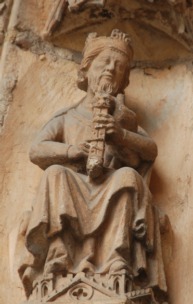
The Cantigas de Santa Maria codex is the main source of medieval music and musical iconography from the Iberian peninsula. The Códice dos Músicos manuscript (Códice E from Escorial), illuminated between 1270 and 1280 (Fernández Fernández L. 2012:81, Chico Picaza M.V. 2003:83), contains two representations of single reed bagpipes. Cantiga 260 shows two players of a drone-less, single cylindrical chanter bagpipe (fig. 25). The left bagpipe seems to have a dress-less bag, but right one shows a red network with some fringes hanging from it. Chanters came out of the bag through respective stocks carved with king-head and dog-head shapes. Both bagpipes display resonators, whose almost straight shapes and large size indicate that they were, very likely, to have been made from carved wood. The similarity of these bagpipes with the rosca is absolutely evident. The Cantiga 280 shows also two bagpipe players (fig. 26); the instruments have a single cylindrical chanter likely finished in a square resonator. In front of the chanters there is a drone. King-head and dog-head carved stocks are also present, as well as dress and dress-less bags.
We can see an angel bagpiper at the Iruña Cathedral (14th century) (fig. 27). The instrument shows a square single chanter, but the main original feature is the dress that covers the bag, and fringes can be seen hanging from it. Another single square chanter drone-less bagpipe can be seen in the portal of Santa María Laguardia (Álava, 14th century). This clearly shows a dog-carved stock together with a beautiful dress bag (fig. 28).
From the facts to speculations
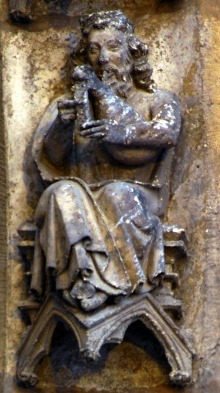
The rosca is the only surviving horn bagpipe from Western Europe (see Baines A. 1960). Along with the other examples of single reed bagpipes that have been found in Galicia, such as the gaitas de vexiga (figs. 1, 10, 11), and the boha from Landes of Gascony in southwestern France, together they form the family of single reed bagpipes from Western Europe. There are no examples from central Europe but they do occur in northern (säckpipa, somu dûdas, labarona duda etc.) and Eastern Europe (gajdy, gajda, carabe, cimpoï, etc.), where there are numerous examples of single reed bagpipes and where there are also other types of horn bagpipes. This European family is clearly connected with bagpipes from North Africa.
The peculiar characteristics of rosca, along with other fieldwork and iconographic data from northwestern pipes and bagpipes, allowed us to approach the solutions to some puzzles that bagpipes family present even today.
The medieval family
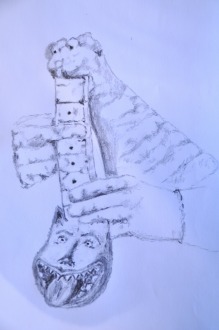
From studying the medieval iconography as highlighted above, we can learn that the Iberian single reed bagpipes were often drone-less and that chanters could be single or double, as well as cylindrical or squared shaped. We have seen a chanter with a ring ornamentation, exactly as the rosca chanter, a pretty, delicate organological detail. It also seems that stocks with a dog-head shape must have been very common in medieval times: if goat-head stocks, which frequently occur on eastern European single reed bagpipes used goat-skins for the bags, could dog-head stocks could indicate that dog skins were used for the bag? One of the facts that we learned from traditional Galician bagpipers was that they considered that dogs made the best hide to make a bag from as the skin had no pores in it – thus helping keep it airtight. Finally, these representations of Iberian medieval single reed bagpipes, demonstrate that instruments similar to the direct- blown rosca and bag-blown rosca are at least 700 years old.
The ring ornamentation

As with a lot of single reed pipes and bagpipes, the rosca has ring ornamentation. We think that this could be a case of skeuomorphism, (i.e. when a derivative object retains ornamental design attributes from structures that are inherent and functional in the original object; this conservation is often the result of a visual custom). As we have already said, among Galician traditional musical instruments we have found a lot of examples of single reed and double reed pipes used by young boys. These were always made with vegetable materials like rye or oat straws, chestnut bark, cane or elder wood. Young boys would always begin by playing these simple and, probably very ancient reedpipes, on their “instrumental pathway” towards playing an adult bagpipe. This pathway or sequence of musical instruments continue with boy’s single reed bagpipes (gaitas de vexiga), and finish with adult double reed chanter bagpipes. This is noticeable that this succession of musical instruments are markedly age-related and closely resembles the history and development of bagpipes.
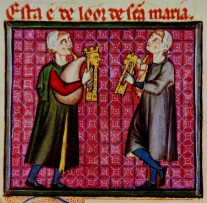
In Galicia there are two ways to create the fingerholes: in straw and chestnut pipes, due to the fibrous nature of the material, they would be cut with a knife either, rarely, with a square shape or, more frequently, by making two cuts in opposite directions. These methods were not usually used in cane or elder pipes, where instead fingerholes were normally bored using a red hot iron rod. It is important to highlight here that cutting tools preceded the use of fire in the history of mankind, and that carved fingerholes precede burnt fingerholes in the boys history. Boring or cutting/carving produces very different visual effects: carved fingerholes appear in the centre of a depression created by the angle of the cuts (fig. 29).
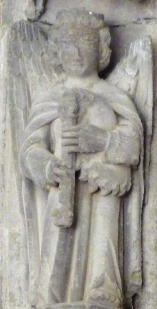
Reedpipes are very old musical instruments, Isturiz, Hohle Fels, Vogelherd and Gleissenklösterle paleolithic bone pipes (among 43,000-11,000 years ago) were probably end-blown flutes, lavrosones or reedpipes (see Morley I., 2013 for a complete view). As we know that ivory and bone pipes were made, then it is more than probable that cane, elder, bark or straw tubes were also made into pipes and we think that this type of pipe would have been more common than bone, as is the case today. Thinking about Paleolithic tools, then it is clear that fingerholes on cane/reed tubes must have been cut with a flint blade, either with square shape or with two opposite cuts, exactly in the same way that Galician boys made theirs, because it is impossible to make a rotative cut with a flint head on fibrous vegetal material. According to Iain Morley (Morley I. 2013:42), some Isturiz, Gleissenklösterle and Hohle Fels pipes show fingerholes that were made by thinning the surface of the bone, creating a cratered depression in which the finger can sit and make an airtight seal, and piercing a hole in the centre of this depression (fig. 30). In our opinion, the cratered depression was not done to make an airtight seal, it is evident that a fingerhole works perfectly without this depression; conversely, we think that it is a case of skeuomorphism, and they were mimicking the depression made by the two cuts on cane/elder pipes. (see fig. 29).
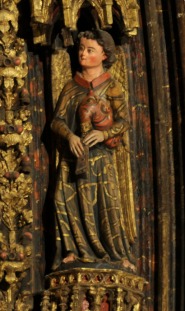
It isn’t only Palaeolithic pipes that show these fingerhole depressions, we think that ring ornamentation, common in today’s single reed end-blown pipes and single reed chanter bagpipes, is the consequence of the very old custom of practice creating fingerholes by the two-cuts technique. Therefore, a case of skeuomorphism: view cutting fingerholes on vegetal pipes, led people to carving wood pipes with ring ornamentation. We show this hypothetical process in figure 31. Thus, the ring ornamentation would be a very old custom, likely rooted in Palaeolithic times. Today ring ornamentation is typical of reedpipes, especially in single reed pipes; taking in account that some Palaeolithic bone pipes seem to show the earliest example of this ornamentation, then it’s possible that such cratered fingerhole pipes were single reeded. Equally, we have also observed that frequently Euroasiatic ring ornamented single reed pipes have a horn bell resonator, many with a serrated edge, which leads us to think that some of the Palaeolithic pipes with initial ring ornamentation would also had these horn bells.

In North Western Iberia we also have a few examples of double reed pipes with ring ornamentation. The small shepherd oboe, the palheta, documented in Portuguese Beira Baixa (Veiga de Oliveira, E. 2000:247) is one such case (fig. 33), but we have also found three very old bagpipe chanters with ivory or horn rings between the fingerholes, an old method of ornamentation which disappeared at the end of the 19th century.
Finally, many pipes have been found in central European Palaeolithic excavations (for a complete revision of them see Morley I. 2013:34), some with the probable presence of incipient ring ornamentation. Their absence in other Palaeolithic excavations outside Europa (Morley I 2013:90) and today’s wide distribution of end-blown (horn or horn-less) reedpipes throughout Europe and North Africa, leads us to think it is likely that there were a European development, arriving in North Africa later, and that we can trace the rosca and others end-blown reedpipes back to Palaeolithic times. Single reed bagpipes developing from these end-blown reedpipes when a bag was added.
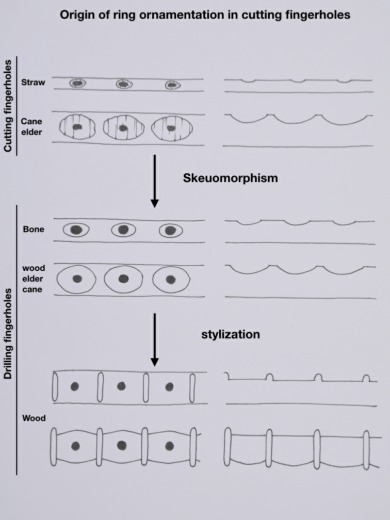
Horn teeth ornamentation
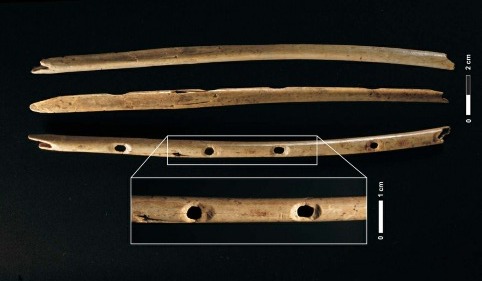
Horns with a serrated edge ornamentation is another common feature of European and North African single reed hornpipes. We have also found this kind of ornamentation in Galician whirling discs (fig. 34), musical instruments which are very similar to “bullroarers” which were involved in religious death rituals (Harding 1973, Montagu 2007). There is a general agreement among archaeologists that the symbolism of dentate ornamentation can be related with solar cults of death and rebirth (Schneider 1998:338). Interestingly, as we mentioned in the first part, the rosca has retained a ritual association with Christmas time, the Catholic celebration of sun, death and rebirth.
The name
Another strange circumstance which connects the rosca with more primitive times is its name. As already mentioned, rosca is an unusual name for a Galician end-blown pipe, as they are normally called gaitas or, in the remote mountain ranges, pipas. Pipa and gaita are synonyms meaning literally “pipe, tube”. To indicate the addition of a bag to reedpipes, another word meaning “bag” is added to “gaita”: thus we have, in all northwestern Iberia, gaita de fol or at southern Ourense mountains, gaita de boto. Why then rosca, a word that only exists in Iberian romances, which means ‘of something with rounded shape’?
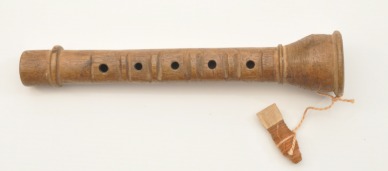
We know, through our friend Juraj Dufek, that in Slovakia, where single reed chanters bagpipes are the most common, that horn bell resonators are so-called rožok, the diminutive of roh, which in Slovakian and Czech languages means horn. The similarity with rosca is evident for us and we have consulted with the famous linguist Mario Alinei, father of the Paleolithic Continuity theory, “it seems to me certainly possible that rosca and rožok are related” was his response.
Rožok are also a characteristic Slovakian sweet twisted cakes, exactly as in the Iberian romances, were rosca also mean a twisted dough, a hair braid, or the turns of a spiral. It seems to us that here the key is “twisted” or “spiral”, because horn are biological structures that, in Eurasiatic fauna, often grow in a helicoidally. In fact, there are many European ‘ro-‘ or ‘ru-‘ rooted words with the sense of a spiral, round, circular or helicoidal movement. In English ‘round’ and ‘root’, the Galician ‘roda’ (wheel) and rosca, the middle Irish ‘rúsc’ (basket of braided bark), the modern Irish ‘rusg’ (the twisted shell of some animals) and others. Thus, we think that the primitive word, from which rosca and roh were derived, should be an object with a helicoidal shape or action. Thinking about imaginary representation of breath, we will have the image of swirls and spirals, interestingly we have found the Arabic ‘rüh’, from the proto-semitic *rūḥ- : to blow, breathe; spirit.

The great linguist, Joan Corominas, points out about rosca etymology that “nothing positive we know today, although a pre-Roman origin is quite sure” (Corominas J. 1980-1991). Rosca and roh words were not related until this date. We are not linguists, but perhaps it has a very old relationship, and perhaps horns, and by extension reedpipes with horn bells, were denominated in Palaeolithic times with the rosca/roh predecessor word. In any case, we think that it is the most plausible explanation for the strange denomination of this Baixo Miño pipe and bagpipe.
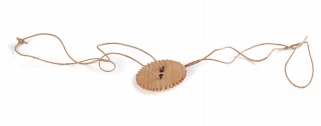
With or without bag?
Other intriguing peculiarity of the baixo miño rosca was the fact that it could be played with or without a bag, a rare feature among bagpipes.
We have found that almost every musical instrument documented in the Palaeolithic archaeological excavations were used by the Galician children until years 1960s: bullroarers and whirling discs, bone and cane rattles, different kinds of whistles, bone and horn flutes, end-blown horns, as well as cane, elder and bark single and double end-blown reedpipes. This astonishing coincidence could be due to the great conservatism of the Galicians and leads us to think that the unusual custom of playing the rosca (or pipa from Bierzo) with or without a bag could date from the time when the bag begun to be used in north-western Iberia. We agree with Antony Baines’ hypothesis about origin of bagpipes, i.e., bagpipes were born when a bag was added to pre-existing end-blown pipes (Baines, A. 1960). Obviously, this process leaves open three possible paths: the conservation of an end-blown pipe, the transformation into a bagpipe or a combination of both. We think that rosca and pipa from Bierzo reflect this last case.
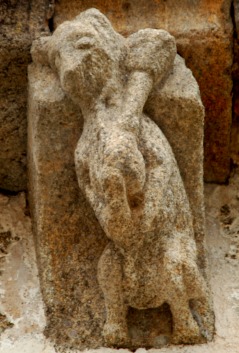
It is difficult to answer the question of when the bag first arrived in Galicia. The first representation of north-western Iberia bagpipe dates back to the 12th century (fig. 35), but these, and 13th and 14th century iconographies show, along with rosca and similar “primitives” bagpipes (figs. 21-28), that at this time there were already highly developed bagpipes with conical chanters and one, or even two, bass drones (fig. 36); hence, the bag arrival must have been earlier than 12th century.
We could agree in part with the unproven diffusionist hypothesis of Curt Sachs that the first bagpipes, most likely single reed bagpipes, came from Asia Minor (Suchs, C. 1947:135)(in this time historians believed that all innovations came from the East, Ex Oriente Lux!). We think that the spatial distribution of single reed (horn) bagpipes in Iberia, North Africa and Balkan countries could indicate an Arabic origin for the concept of the bag: we found this kind of bagpipe was deeply rooted at the two main gateways to Europe from the Arabic world (fig. 38). That Iberia has undergone, from 8th century, and especially from 11th, a huge Arabic influence is beyond doubt and we can say the same about the Balkans. Here the Arabic cultural influence come in through Bosphorus strait because of trade routes and/or people movements both of which were well documented from prehistoric times (Cunliffe B. 2011).
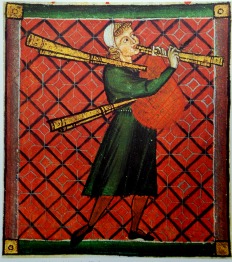
On the other hand, the word pipa has a wide distribution throughout the European peninsula (fig. 39) and has its origin from Indo-European root *pip(p) (Pokorny, J. 2002), likely onomatopoeic, both indicate a very old origin for pipe or pi- xi- etc. rooted words. Examples across Europe are the Galician pipa, xipro and pínfano, the Portuguese pipa, the Italian pipa, the French pipe, Old Frisian pipe, German pfeife, Danish pibe, Swedish pipa, Dutch pijp, Slovenian pípa, Serbian pipa, Greek πῖπος, etc. Mostly, these words refer in the European peninsula to musical instruments such as reedpipes and flutes, and surely by extension, diverse kinds of tubes. Nevertheless, obviously in more recent times, this old term was partially replaced by two others, which also refer musical pipes: gaita and some derivatives of dudu- root.
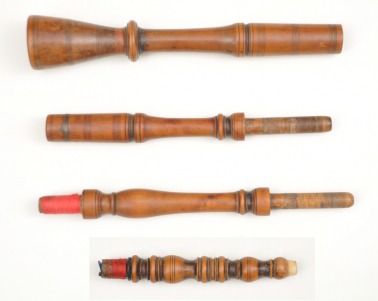
Dudu- rooted words are used in eastern Europe to denominate flutes, reedpipes or bagpipes: we found duda in Ukraine, Croatia, Hungary and Belarus, düdas or dud Maïshis in Latvia, as well as dudey in Germany and Netherlands during the 17th century and dudelsack in Germany. These terms were probably borrowing from Armenian or Ottoman Turkish languages, where duduk means reedpipe. The eastern European distribution of such a musical related words (fig. 40), show how an Arabic influence reached even the Nordic countries from the Bosphorus strait. Moreover, we have found dudu- related terms in Iberia: tutu or turuta, both meaning pipe in Basque country, turuta in Extremadura to refer a single reed pipe, or even tuto in Galician to refer a cane tube.
Gaita has an equally intriguing distribution because we found this word only in Iberia and the Balkan countries, where it denominates all kinds of end-blown reedpipes and bagpipes, or literally pipe. This “bow” distribution could reinforces the hypothesis for the Arabic etymology of the gaita word (Bec, P. 2004:57).
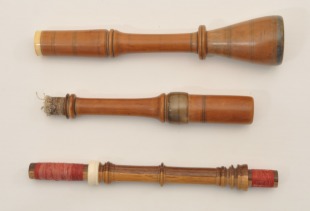
Taking together the spatial distribution of gaita and dudu- terms, as well as the Iberian and Balkan presence of single reed horn bagpipes (likely the first end-blown pipes that have incorporated the bag), all showing a “bow” distribution that penetrates European peninsula from northern Africa, it’s possible agree with the origin of bagpipes bag in Asia Minor. Using a diffusionist hypothesis, given the Iberian iconographic explosion of bagpipes from 12th century, the bag idea could have arrived into Iberia, maybe into Balkan countries and even in India, around the 8-9th century. Barry Cunliffe wrote about the 8th: “The Muslim world now extended from the Atlantic to the Indus: it was the largest empire the world had ever known” (Cunliffe, B. 2011:423). Other linguistic observation could reinforce this idea: in the Galician language the word “bag” is never added to “pipe”, this happens only with the word “gaita” of probable medieval origin; such a fact seems to indicate that the appearance of the bag in Galicia could be coeval with the entrance of the word “gaita” in our language.
In any case, we must bear always in mind other possibilities and that the bag may have had a number of different origins. The archaeological data indicates that reedpipes could have their origin or greatest development in Paleolithic Eurasia. Thus, the bag could also be linked to reedpipes somewhere in Eurasia, perhaps in the Iberian Peninsula, where the oldest depictions of bagpipe appear. The words with du- or tu- roots could be of a very old, onomatopoeic origin and could only have been preserved in certain areas; likewise, the word gaita could have originated in the Iberian Peninsula (the Menéndez Pidal hypothesis) and spread through northern Africa to the Balkans.
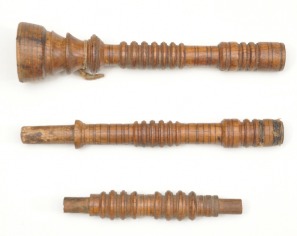
According with the development of archaeology and linguistics in the last 50 years, our intuition is that the current dating of the origin/birth of the bagpipe could be much earlier than previously thought. The data about bagpipes dating from ancient Greece and Rome could indicate that bagpipes were present amongst the agrarian European Neolithic population. If bagpipes were developed during the 9th century, we think that 300 years is not enough time to explain the huge variety of bagpipes found in Iberia, England, France and other countries in 13th. Perhaps the explanation of the birth of the western European bagpipes through the Muslim invasion is the repetition of the archaeological invasionist paradigm, discarded in the 20th century. Perhaps the skeuomorphism found in the rosca and other Palaeolithic ornamented pipes is the true indicator of the age of the reed pipes. We believe that vegetal reed pipes were used in Palaeolithic times and that bag was developed and added to reedpipes with the first Indo-European farmers and shepherds in early Neolithic times.
Blowpipe ornamentation
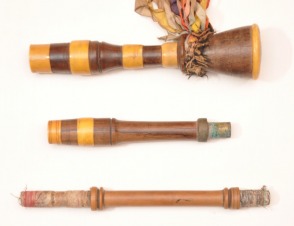
Finally! We have observed that while the bass drone and chanter turning designs were very simple, especially in old bagpipes (fig. 37), the blowpipes show a ring and barrel-shape ornamentation absolutely similar to rosca ones. We think that it’s possible that when the bag arrived or developed in north-western Iberia, it was initially incorporated into reedpipes with ring ornamentation. Having a bag required a blowpipe and that was ornamented like the chanter, another skeuomorphism case, producing drone-less bagpipes similar to rosca and establishing the habit of sculpting the blowpipes with rings and barrels.
It is possible that around 11-12th century in Ibera, one over the shoulder bass drone was added to these drone-less bagpipes. As we have already mentioned, there are three examples of double reed chanters, with ivory or horn rings ornamentation which have been documented in southern Galicia, at Pontevedra (fig. 33). If this kind of chanter was added to bags and following the already stated logic, then bagpipes with ring-ornamented bass drones must be found. In fact, among the 295 bagpipes documented we have found four bass drones with a ivory, horn or wood ring ornamentation, all from the Pontevedra area, as you can see in the figure 42.
Conclusion
The facts are that the rosca is the only horn bagpipe alive in Western Europe and that we can trace it back to medieval times throughout iconography. Likewise, there is an evident link between the rosca and Balkan single reed bagpipes: the single reeds, chanter’s horn bells and ring ornamentation and even the name itself.
It’s true that some of our hypotheses are quite speculative, with it we only intend to stimulate the imagination and to show that, to advance in the bagpipe history, we need more and more field work on bagpipes to discover the small details. Because in them we will find, with the collaboration of linguistic and archaeological specialists, some answers that we are still looking for.
Acknowledgments: Thank you to Jane Moulder for editing the article. Thanks to Luis Alberto Mondelo for the photography from Leon cathedral; Dani García de la Cuesta for Iruña bagpiper photography, Luis A. Payno for single reed pipes and Juan Mari Beltran for alboka photography. Other photographs are by Pablo Carpintero and Alba Vázquez Carpenter. Thanks also to all the traditional Galician musicians who have transmitted their knowledge and experiences.
BIBLIOGRAPHY
Baines, A. (1960) Bagpipes. Occasional papers on technology, 9. Ed. Penniman and B.M. Blackwodd. Pitt Rivers Museum. University of Oxford.
Bec, P. (2004) Les instruments de musique d’origine arabe. ISATIS Cahiers d’ethnomusicologie régionale, pp.57-
Beltran, J.M. (2004) Albokaren Alde Batzuk. Ed. Herri Musikaren Txokoa.
Carpintero, P. (2009) Os instrumentos musicais na tradición galega. Ed. Difusora de letras artes e ideas.
Chico Picaza M.V. (2003) “The medieval theory of Music and the miniatures of the Cantigas”. Anales de Historia del Arte 13, pp. 83-95.
Corominas, J. (1980-1991) Diccionario crítico etimológico castellano e hispánico. Madrid: Gredos, 1980-1991, entrada “Rosca”.
Cunliffe, B. (2011) Europe between the oceans 9000 BC-AD 1000. New Haven and London: Yale University Press.
Fernández Fernández L. (2012) “Los manuscritos de las Cantigas de Santa María: definición material de un proyecto regio”. Alcanate VIII, pp 81 - 117.
García Matos, M. (1956) “Instrumentos Musicales folklóricos de España. III. La “alboka” vasca”. Anuario Musical, pp. 131-144.
García Matos, M. (1956) “Instrumentos Musicales folklóricos de España. II. La “gaita” de la sierra de Madrid”. Anuario Musical. pp. 123-131
García-Matos, M.C. (1983) “La turuta, instrumento pastoril de un pueblo de Extremadura”. Revista de Musicología. Vol. VI, , nº 1-2, pp. 1-18
Harding, J. (1973) The bull-roarer in history and in antiquity. African Music 5, pp. 40-2.
Montagu, J. (2007) Origins and development of musical instruments. Lanham: Scarecrow Press.
Morley I. (2013) The prehistory of Music. Human Evolution, Archaeology and the origins of musicality. Oxford University Press.
Payno L. A. (1993) “La chifla de Campoo”. En: Revista de Folklore. (13b) nº154, pp. 111-117.
Pokorny, J. (2002) Indogermanisches Etymologisches Wörterbuch. Francke.
Sachs, C. (1947) Historia universal de los instrumentos musicales. Buenos Aires: Ed. Centurión, pp. 135-136.
Schneider, M. (1998) El origen musical de los animales-símbolos en la mitología y la cultura antiguas. Ediciones Siruela, p 338.
Veiga de Oliveira, E. (2000) Instrumentos Musicais Populares Portugueses. Fundaçao Calouste Gulbenkian, Lisboa, pp. 247-248.
- Data Processing Notice (GDPR)
-
@BagpipeSociety on X (formally known as Twitter)
-
TheBagpipeSociety on Instagram
-
 BagpipeSociety on Facebook
BagpipeSociety on Facebook
Something wrong or missing from this page? Let us know!
